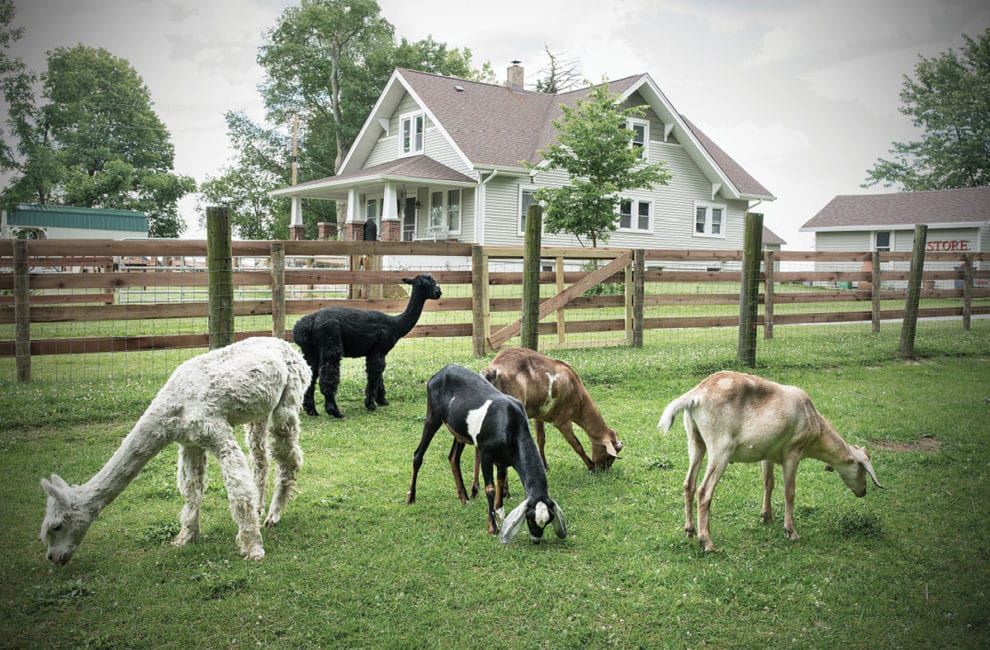
Goats and alpacas graze on land surrounding a refurbished farmhouse
Field Of Dreams: How I Became A Farmer
I am a farmer.
When friends hear me speak of it, they make references to the 1960s sitcom Green Acres, which featured the journey from “high society” to “hillbilly” that one New York City couple took when they moved to a farm. I understand the comparison: I am the most unusual of suspects to be living in the country.

Randy and Sherri Dugger tend their herd.
Agriculture played no part in my youth. I grew up in a middle-class ranch home on the south side of Indianapolis, where I spent years believing I’d one day be a magazine editor, a motorcycle owner, and a resident of New York City. I eventually became all three. For nearly two decades, I earned my keep with ink-and-paper proofs, authoring books, producing international art magazines, and editing a long list of regional publications, including this one. Now—just a few years after trading in a professional wardrobe for overalls and Muck boots—this former roller girl and nutritional ne’er-do-well runs a 3.5-acre patch of Shelby County, Dugger Family Farm. I begin and end each day with critters, hauling five-gallon buckets of water for their hydration, rationing out feed, and pitchforking spent straw into compost piles. I hang with goats more than I do city folk. My hands are often stained with beet juice or dirt or both, and I gleefully eat straight from the gardens, plucking sugar snap peas and burying my head in basil leaves just to breathe deeply of our world’s sweet aroma.
I also serve as a media and outreach director for the Indiana Farmers Union, advocating for the family farmer, local food, and sustainable, diversified agriculture. My husband, Randy, and I keep seven goats, two alpacas, 30-some chickens, two dogs, a tribe of farm cats, and thousands of honeybees. The chickens pay rent by providing us with daily eggs. The honeybees pollinate our gardens. We don’t harvest the honey they produce, instead leaving the sweet treat so they can eat well during harsh Indiana winters. Our other animals have mostly arrived as rescues, and they will live out their days on the farm duty-free. Beyond the livestock, we manage a small farm store out of a remodeled garage, where we sell locally raised foods to neighbors, passersby, and agritourists from Indy.
We spent a year of weekends restoring this old farmhouse that needed a complete kitchen and bathroom overhaul, new electricity and plumbing, insulation, a new furnace and wood stove, and mold remediation before Randy and I could even move in. That was late 2013. We’ve been working ever since, cleaning up trash, putting up fences, and doing what we can to birth a diversified operation from a small tract of once-neglected land. In the coming year, we plan to construct a facility to house an expanded store, commercial kitchen, and event space, and to restore a 1955 Ford van for use as a mobile food market. We hope to establish more than just a working farm here, to fashion a place where friends, family, and neighbors can congregate. We are creating a community.
What drove me to want to live in the country I cannot clearly explain. I suppose I romanticized the idea of Randy and me living together remotely, quietly. I believed life would be simpler out here, doing so without taking into account one important factor: me. I dream big and, for better or worse, am regularly stricken with ideas. My husband, skilled as he is in construction, is able to turn those desires into realities. We each play to our strengths. I manage the details of running a farm business, and he tends to the heavy lifting. Together, we have become farmers.
Maybe the biggest transformation that has taken place on our farm hasn’t been in the physical realm, but rather inside me. Eating is now an ethical act. It involves showing respect for the land, for the animals, and for the air we breathe. My time on the farm has taught me well how to feed myself and others. Each choice I make with my food dollars casts waves throughout the environment and our local economy. Each day, I learn something new about this gig—the importance of soil health to our food systems, for instance, or the impact of animal agriculture on our world’s supply of natural resources. Life now revolves around making sustainable food choices, for our physical health, as well as for the endurance of our land.
And here’s a little secret: I may be living the Green Acres life, but I have never watched a single episode. If only I had that kind of time.
Farm-to-Table Faves
A spring picnic of local goods (plus a chicken on sick leave and her best friend).


An old garage holds a farm store that’s open Thursday through Sunday.Photo by Tony Valainis
Farm Store Shopping List
- 2Morrow’s Farm
- B. Happy Peanut Butter
- Bastin Honey Bee Farm
- Batch No. 2
- BeeFree Gluten-Free
- Best Boy & Co.
- Blue River Roasters
- Brendle Honey Farm
- Broad Ripple Chip Co.
- Caprini Creamery
- Dillman Farm
- Fair Farms & Produce
- Foods Alive
- Fresco Spice Blends
- Healthy Hoosier Oil
- Hoosier Farms
- Husk
- Kick Out The Jams
- LocalFolks Foods
- Revival Food Co.
- Tulip Tree Creamery
- Urban Ladle
- Well Done Beef





